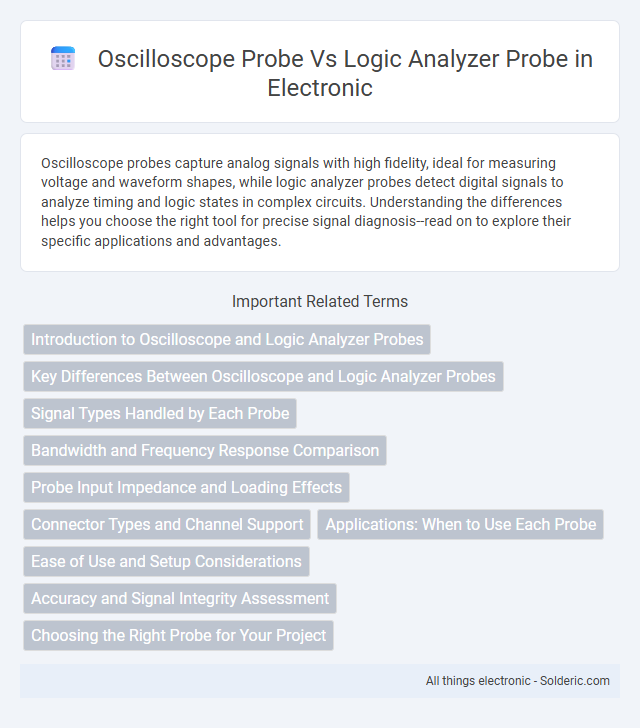Oscilloscope probes capture analog signals with high fidelity, ideal for measuring voltage and waveform shapes, while logic analyzer probes detect digital signals to analyze timing and logic states in complex circuits. Understanding the differences helps you choose the right tool for precise signal diagnosis--read on to explore their specific applications and advantages.
Comparison Table
| Feature | Oscilloscope Probe | Logic Analyzer Probe |
|---|---|---|
| Purpose | Measure analog signals and waveform characteristics | Capture and analyze digital signals and logic states |
| Signal Type | Analog and digital mixed signals | Digital signals only |
| Bandwidth | High bandwidth (up to GHz range) | Lower bandwidth optimized for digital timing |
| Channels | Typically few (2-4 channels) | Many channels (16, 32, or more) |
| Signal Integrity | High precision, low loading on circuit | Moderate precision, higher loading acceptable |
| Measurement Focus | Voltage, frequency, rise-time, waveform shape | Logic states, timing relationships, protocol decoding |
| Typical Usage | Electrical debugging, analog circuit testing | Digital system debugging, protocol analysis |
| Connector Type | Single-tip probe, BNC or compatible | Multiple clips/taps for parallel signals |
Introduction to Oscilloscope and Logic Analyzer Probes
Oscilloscope probes are designed to capture analog signals with high bandwidth and precise voltage measurements, enabling detailed waveform analysis of electronic circuits. Logic analyzer probes specialize in capturing digital signals across multiple channels simultaneously, allowing for complex timing and protocol analysis in digital systems. Both probes are essential tools in electronics testing, each optimized for either analog or digital signal acquisition to support accurate diagnostics and debugging.
Key Differences Between Oscilloscope and Logic Analyzer Probes
Oscilloscope probes are designed for measuring analog signals with high bandwidth and accuracy, capturing voltage waveforms in real time. Logic analyzer probes specialize in digital signal acquisition, monitoring multiple channels simultaneously to analyze timing relationships and digital data states. Your choice depends on whether you need precise analog signal analysis or comprehensive digital logic inspection.
Signal Types Handled by Each Probe
Oscilloscope probes are designed primarily to capture analog signals, allowing precise observation of voltage waveforms with high bandwidth and minimal distortion. Logic analyzer probes are specialized for digital signals, efficiently sampling multiple channels simultaneously to analyze timing and logic states in complex digital circuits. Your choice depends on whether you need detailed analog signal integrity measurements or comprehensive digital signal timing and logic analysis.
Bandwidth and Frequency Response Comparison
Oscilloscope probes typically offer higher bandwidth and superior frequency response compared to logic analyzer probes, supporting signals up to several GHz for accurate analog waveform analysis. Logic analyzer probes prioritize digital signal integrity with bandwidths often limited to a few hundred MHz, optimized for capturing digital transitions rather than detailed analog characteristics. Choosing between these probes depends on the required measurement fidelity, where oscilloscopes excel in high-frequency analog signals and logic analyzers serve best for digital timing and protocol analysis.
Probe Input Impedance and Loading Effects
Oscilloscope probes typically have input impedances around 1 MO with low capacitance (a few pF), minimizing circuit loading and preserving signal integrity during analog measurements. Logic analyzer probes often feature lower input impedance and higher capacitance due to multi-channel multiplexing, which can introduce greater loading effects on digital circuits, potentially altering signal timing and logic levels. Understanding these impedance differences is critical for selecting the appropriate probe to accurately capture high-frequency or sensitive signals without distortion.
Connector Types and Channel Support
Oscilloscope probes typically use BNC connectors for secure, low-noise signal transmission, supporting one channel per probe, which is ideal for detailed waveform analysis on a single signal line. Logic analyzer probes often utilize multi-pin connectors such as IDC or proprietary headers to handle numerous channels simultaneously, enabling you to capture and analyze complex digital bus signals in parallel. Selecting the appropriate probe depends on your need for channel density and connector compatibility with your measurement instrument.
Applications: When to Use Each Probe
Oscilloscope probes are ideal for capturing analog signal waveforms, measuring voltage, frequency, and transient events in real-time for applications such as circuit debugging and signal integrity analysis. Logic analyzer probes excel in capturing and analyzing digital signals, enabling timing analysis, protocol decoding, and troubleshooting of digital communication buses like SPI, I2C, and UART. Use oscilloscopes for high-fidelity analog measurements and logic analyzers when monitoring complex digital systems with multiple signal channels.
Ease of Use and Setup Considerations
Oscilloscope probes are generally easier to set up, featuring straightforward connections and simple calibration suitable for capturing analog signals with minimal configuration. Logic analyzer probes require more complex setups due to the need to interface with multiple digital channels and specify timing parameters, which can increase initial calibration time. The choice depends on the measurement focus--oscilloscopes excel in analog waveform analysis with quick setup, whereas logic analyzers demand detailed wiring but provide comprehensive digital signal insight.
Accuracy and Signal Integrity Assessment
Oscilloscope probes offer high bandwidth and low capacitance, ensuring accurate voltage measurements and preserving signal integrity for analog and high-frequency signals. Logic analyzer probes, designed for digital signal capture, focus on low loading and precise timing analysis but typically have lower bandwidth compared to oscilloscope probes. For precise accuracy and minimal signal distortion in mixed-signal environments, selecting the probe based on bandwidth, input capacitance, and rise time specifications is critical.
Choosing the Right Probe for Your Project
Selecting the right probe for your project depends on the signal type and measurement requirements. Oscilloscope probes are ideal for capturing analog waveforms with high bandwidth and fine voltage resolution, while logic analyzer probes excel at monitoring multiple digital signals simultaneously for timing and protocol analysis. Understanding the need for precise analog measurements or comprehensive digital logic capturing ensures optimal data accuracy and troubleshooting efficiency.
oscilloscope probe vs logic analyzer probe Infographic

 solderic.com
solderic.com